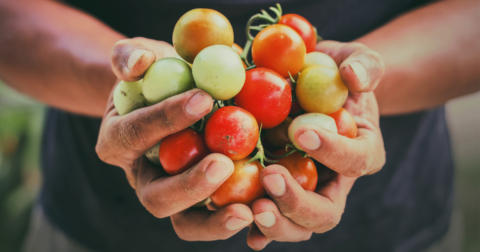Feature
How Much Meat Can You Eat and Still Be ‘Climate-Friendly?’
Research•9 min read
Explainer
It’s a question people love to throw at vegans and vegetarians — so here’s a thorough explanation.


Words by Seth Millstein
When vegans and vegetarians argue against eating meat because of the pain it inflicts on animals, they’re often met with a pithy-sounding retort: What if plants feel pain, too? You can’t prove that they don’t, the argument goes, so isn’t a plant-based diet potentially inflicting just as much pain as a meat-based one?
It’s a common argument, but it isn’t a good one. Plants are incredibly complex organisms, and scientists have made some extraordinary discoveries in recent years about how plants process and respond to external stimuli. However, absolutely nothing that we know about plants suggests that they’re capable of feeling pain, or anything similar to the sensation we know as pain. Here’s why.
At its core, pain is a warning system — your body’s way of prompting you to make changes to your circumstances to avoid injury.
The experience of pain is closely associated with a type of nerve ending called a nociceptor. When the body is exposed to potentially injurious stimuli — an extreme temperature or laceration, for instance — nociceptors communicate this to the brain, and the brain in turn creates a pain sensation.
There are certain rare situations wherein it’s possible to experience pain without nociceptors; the classic example is phantom limb pain, when an amputee feels pain in a limb that they no longer have. Phantom limb pain is a poorly understood condition that perplexes scientists to this day, but it is relevant to the question of plant pain, as we’ll see in a moment.
In short, no. It’s notoriously difficult to prove the non-existence of something, and doubly so when that thing is a subjective experience like pain. That said, almost everything we know about plants suggests that they aren’t capable of feeling pain — or anything, for that matter.
For one, plants don’t have nociceptors, nervous systems or brains. In species that do experience pain, the nervous system and the brain are both integral to that experience: the nervous system detects a noxious stimulus, and the brain creates the sensation of pain when it receives this message from the nervous system.
As mentioned earlier, the existence of phantom limb pain means that it is possible for someone to experience pain without having nociceptors at the site of the pain. But it’s not possible to experience phantom limb pain without a brain and a nervous system, and the phenomenon of phantom limb pain suggests that pain is ultimately constructed in the brain.
“Plants definitely perceive and respond to touch and temperature changes, but I am disinclined to say they ‘feel,’” Dr. Elizabeth Van Volkenburgh, a plant biologist, wrote in Psychology Today. “The whole business of feeling relies on a brain, and plants don’t have brains.”
As Van Volkenburgh notes, plants are able to respond to external stimuli. We’ve all seen time-lapse videos of flowers rotating throughout the day to make sure they’re always facing the sun, but plant reactions go beyond this. Many plants emit chemicals when they’re cut or damaged, for instance; these chemicals can serve various purposes, from warning other nearby plants of the danger to poisoning whoever is causing the damage.
In other words, when plants are exposed to something threatening, they will sometimes respond in ways that, to our eyes, look a lot like a reaction to pain. And it’s true that pain is sometimes measured by observing how an organism reacts to ostensibly painful stimuli in their environment; if a friend stubs their toe and starts screaming in agony, for instance, you might reasonably conclude that they’re in pain.
But the fact that plants sometimes behave in ways that we associate with pain doesn’t prove that they’re actually feeling pain, because behavior doesn’t always correlate with experience in expected ways. It’s possible for an organism to be in pain without changing its behavior; chickens are notorious for hiding their pain when sick or injured, for instance. And it’s easy to act like you’re in pain when you aren’t, as demonstrated by this video of a cat pretending to be injured in order to convince someone to let them inside their house.
The way plants respond to injuries isn’t an example of pain, but rather, an example of a defense mechanism. Plants, like humans, have evolved ways to defend themselves against external threats, and while our defense involves a pain sensation, theirs does not. One could even argue that plants, in this one very specific sense, are more highly evolved than we are: they can effectively defend themselves against harm without experiencing unpleasant feelings of physical agony.
If pain can never be directly observed, only experienced and inferred, how can we ever know that another organism is in pain?
In the most narrow technical sense, we can’t. But in the most narrow technical sense, we also can’t even be sure that other people exist — so scientists take a slightly less philosophical, more holistic approach when attempting to determine whether other animals can feel pain.
Generally speaking, scientists infer that animals feel pain using a few different tools — namely, existing knowledge of the human experience and how humans traditionally react to pain, observations of animal responses to potentially injurious stimuli or events, and the presence or absence of pain receptors, nervous systems and brains in said animals.
Using these tools, scientists have concluded that most animals do feel pain, including not only mammals but also fish, reptiles, and even some decapods like lobsters and crabs. These animals are very dissimilar from each other, but they all have two big things in common: nervous systems and brains. Plants lack both, and scientists have thus been unable to conclude that they’re able to feel pain.
It’s absolutely crucial to point out that just because plants can’t feel pain doesn’t mean we should view them as disposable or unimportant. On the contrary: plants are extremely, extremely important. In the most literal sense possible, we would all be dead without them.
If not for plants, we wouldn’t be able to breathe, as they’re the ones that oxygenate the air around us. Without plants, we’d starve to death — not just because we eat them, but because the animals that many people eat also eat them. Plants play a crucial role in keeping the planet’s temperatures within a livable range, and are essential ingredients in as much as 40 percent of the medications people use every day.
There are plenty of other vital purposes plants serve, but the point is clear: just because plants don’t feel pain, doesn’t mean they don’t matter. They most definitely do.
The reason plants can’t feel pain is because they lack nervous systems and brains. This is also the precise reason why so many nonhuman animals, including the many that we kill by the millions every day for food, can and do feel pain. To understand why plants can’t feel pain is to understand why animals can. Wider recognition of this difference should arguably lead more people to more seriously consider animals’ experiences of pain when deciding what to eat.